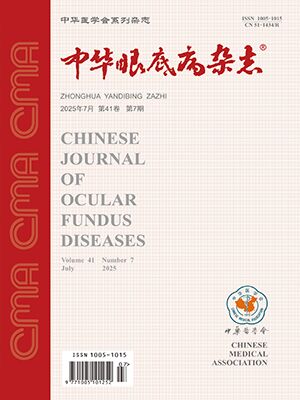Objective To evaluate the outcomes of laser photocoagulation of congenital X-linked retinoschisis (XLRS) at progressive stage.
Methods Twenty-seven cases (36 eyes) of XLRS sick kids were enrolled in this study. All patients were followed up for more than 1 year, retinoschisis has developed slowly but complications occurred during the follow-up. They are all boys from 3 to 12 years old; the average age was 6.47 years old. There were 18 unilateral cases, 9 bilateral cases. The affected eyes were randomly divided into treatment group and control group (n=18 eyes). The treatment group eyes received multi-wavelength krypton yellow laser photocoagulation around the retinoschisis, but no laser spots were laid in a optic-disk area surrounding the macular and optic disc. Children in the control group were followed up every six months without treatment. Both groups of children were followed up for 3 years. The best corrected visual acuity (BCVA, logMAR), complications (vitreous hemorrhage, retinal detachment) were measured at the last follow up.
Results At the last follow-up, the treatment group mean logMAR BCVA was 0.73±0.41, which is the same as pre-treatment BCVA (t=1.187, P=0.201). The control group mean logMAR BCVA 0.88 ±0.60, which is the same as pre-treatment BCVA (t=-2.093, P=0.033). The changes of the BCVA in these two groups was statistically different (t=-2.093, P=0.033). For the treated 18 eyes, visual acuity improved in four eyes (22.2%); not changed in 10 eyes (55.6%) and decreased in four eyes (22.2%). For the 18 eyes in the control group, visual acuity improved in three eyes (16.7%); not changed in four eyes (22.2%) and decreased in 11 eyes (61.1%). The vision reduction rate in treatment group was statistically less than the control group (χ2=5.600, P<0.01). There were 2 eyes (11.1%) and 7 eyes (38.9%) with serious complications in the treated and control eyes respectively. The complication rate treatment group was statistically less than the control group (χ2=3.710,P<0.05).
Conclusion Laser photocoagulation can stabilize or improve vision of advanced XLRS patients, and prevent the occurrence of serious complications.
Citation:
ZhaoChen, ZhangQi, ZhangQin. Photocoagulation of X-linked congenital retinoschisis in progress stage. Chinese Journal of Ocular Fundus Diseases, 2014, 30(1): 38-41. doi: 10.3760/cma.j.issn.1005-1015.2014.01.010
Copy
Copyright © the editorial department of Chinese Journal of Ocular Fundus Diseases of West China Medical Publisher. All rights reserved
| 1. |
Wu WC,Drenser KA,Capone A,et al. Plasmin enzyme-assisted vitreoretinal surgery in congenital X-linkde retinoschisis:surgical techniques based on a new classification system[J]. Retina,2007,27:1079-1089.
|
| 2. |
Sikkink SK, Biswas S, Parry NR, et al. X-linked retinoschisis:an update[J]. J Med Genet, 2007, 44:225-232.
|
| 3. |
Kellner U, Brummer S, Foerster MH, et al. X-linked congenital retinoschisis[J]. Graefe's Arch Clin Exp Ophthalmol, 1990, 228:432-437.
|
| 4. |
Kjellström S,Vijayasarathy C,Ponjavic V,et al. Long-term 12 year follow-up of X-linked congenital retinoschisis[J].Ophthalmic Genet, 2010, 31:114-125.
|
| 5. |
Condon GP, Brownstein S, Wang NS, et al.Congenital hereditary (juvenile X-linked) retinoschisis.Histopathologic and ultrastructural findings in three eyes[J]. Arch Ophthalmol, 1986, 104:576-583.
|
| 6. |
黄时洲,吴德正,江福钿,等.遗传性视网膜劈裂症的多焦视网膜图改变[J].中华眼底病杂志,2001,17:278-270.
|
| 7. |
George ND,Yates JR,Bradshaw K,et al.Infantile presentation of X-linked retinoschisis[J].Br J Ophthalmol,1995,79:697-702.
|
| 8. |
George ND,Yates JR,Moore AT.Clinical features in affected males with X-linked retinoschisis[J].Arch Ophthalmol,l996,l14:274-280.
|
- 1. Wu WC,Drenser KA,Capone A,et al. Plasmin enzyme-assisted vitreoretinal surgery in congenital X-linkde retinoschisis:surgical techniques based on a new classification system[J]. Retina,2007,27:1079-1089.
- 2. Sikkink SK, Biswas S, Parry NR, et al. X-linked retinoschisis:an update[J]. J Med Genet, 2007, 44:225-232.
- 3. Kellner U, Brummer S, Foerster MH, et al. X-linked congenital retinoschisis[J]. Graefe's Arch Clin Exp Ophthalmol, 1990, 228:432-437.
- 4. Kjellström S,Vijayasarathy C,Ponjavic V,et al. Long-term 12 year follow-up of X-linked congenital retinoschisis[J].Ophthalmic Genet, 2010, 31:114-125.
- 5. Condon GP, Brownstein S, Wang NS, et al.Congenital hereditary (juvenile X-linked) retinoschisis.Histopathologic and ultrastructural findings in three eyes[J]. Arch Ophthalmol, 1986, 104:576-583.
- 6. 黄时洲,吴德正,江福钿,等.遗传性视网膜劈裂症的多焦视网膜图改变[J].中华眼底病杂志,2001,17:278-270.
- 7. George ND,Yates JR,Bradshaw K,et al.Infantile presentation of X-linked retinoschisis[J].Br J Ophthalmol,1995,79:697-702.
- 8. George ND,Yates JR,Moore AT.Clinical features in affected males with X-linked retinoschisis[J].Arch Ophthalmol,l996,l14:274-280.




